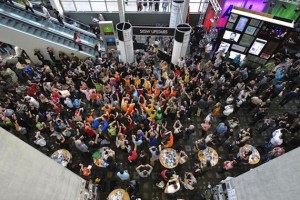
Between March 9 and 18, nearly 25,000 people armed with smart phones, tablets, laptops and netbooks, converged on the city of Austin, Texas for the South by Southwest Conference, an annual eclectic gathering of musical artists, filmmakers and technology geeks.
Proliferation of the mobile Wi-Fi gadgets spotted in Austin in public and in the workplace comprise a trend called “BYOD” — Bring Your Own Device. The term has special significance for conferences like SXSW.
SXSW attendance has surged over 227 percent in the past two years alone, due in large part to the Interactive, or technology-focused events. But while conference organizers celebrate the ever-increasing number of visitors, those responsible for maintaining a stable wireless network for the masses are faced with a serious challenge.
“The bottlenecks tend to be saturation of the airwaves,” said Joe Gonzalez, head of information technology at the Austin Convention Center. The wireless network on site is built to handle large numbers of users, but, “too many folks bringing their own Mi-Fi hotspots creates so much interference that people can’t connect to our network.”
Gonzalez describes incidents where exhibitors had “cameras blasting signal into the air,” or where there was a device broadcasting from inside a locked closet, causing interference. But when conference organizers encourage their attendees to shut off their mobile hotspots and log on to the center’s Wi-Fi, airspace remains clear. “The SXSW crowd tends to be more knowledgeable in this area,” he said.
What stole the show at this year’s conference was a controversial project called “Homeless Hotspots.” Local homeless people were recruited by a British marketing agency called BBH Labs to sell high speed Internet access to attendees. The individuals involved seemed generally happy to participate, but critics have suggested that the homeless have been forced to “lose a measure of their humanity” by participating. Tim Carmody of Wired magazine went so far as to say, “[The project] sounds like something out of a darkly satirical science-fiction dystopia.”
While not an officially-sponsored offering by the conference, “Homeless Hotpots” has highlighted the growing demand for top quality wireless speed at all kinds of venues – and the different strategies that are being employed to provide that access to users.
Amy Maier is the spokeswoman for Smart City Networks, the internet provider for the Las Vegas Convention Center. “Not all networks are created equal” when it comes to coverage and connectivity, she said. The LVCA has introduced a tiered pricing plan: its “free, basic Wi-Fi access” is available in public areas, while a “premium connection” offers “more bandwidth for $12.95 per day.”
A March article titled “Bring your own disaster” in the Sydney Morning Herald warns of the security risks that follow personal phones and laptops into the workplace. “Look at how most people treat their portable devices, and then ask yourself if you’d want your sensitive information sitting on those gadgets,” Adam Turner wrote.
“We’ve become so dependent on Wi-Fi that losing access changes our ability to function,” said Stanford electrical engineering Professor Andrea Goldsmith, a leading expert on wireless networks. And while there are some data security risks inherent in BYOD environments, she believes that sensitive data is migrating off of devices and into the cloud. Compromised devices can also be “wiped” from a remote location, so the “risk of data getting into the wrong hands is probably overstated.”
Dangerous or not, more organizations are setting up new networks to accommodate the BYOD trend; and this creates a wealth of opportunity for the enterprise wireless LAN market. According to a recent report published by the International Data Corporation (IDC), the market grew 30 percent in 2011, reaching the $3 billion mark. Leading the market were Cisco Systems, Inc., with around a 51 percent share, and Aruba Networks, Inc., which holds an 11.6 percent share. Small WLAN companies make up 25-30 percent of the market, and are looking for ways they can compete through differentiation.
Meraki Networks, based in San Francisco, has tailored some of its product offerings for organizations that do not have the IT manpower to constantly monitor a network. “If you’re a school, hospital or retailer, you need a plug it and forget it solution,” explained Kiren Sekar, vice president of marketing.
David Callisch, vice president of corporate marketing at Sunnyvale-based Ruckus Wireless, Inc., has identified mobile carriers as a special “niche” for his company.
“Carriers are used to buying and licensing spectrum and are new to the Wi-Fi game,” he said. Callisch sees this as is an open invitation for partnering with Wi-Fi providers. Ruckus Wireless, which has been cash flow positive for the past six quarters, is one of the few wireless companies with plans to IPO in the near future.
“It’s hard to IPO if you’re a real tech company, since there isn’t a lot of venture capital to go around. This isn’t quite like social media,” said Professor Goldsmith, who co-founded her own wireless company, Quantenna Communications, Inc., in 2006.
A strategic alternative for smaller wireless providers in a time of market growth is to seek a buyer. Acquisitions are growing more common, especially with large hardware companies and mobile carriers looking to offer wireless service to their customers. Ericsson, for example, acquired BelAir Networks, a Ruckus competitor in the carrier space, in February. Dell purchased networking hardware provider Force10 last year.
“Everybody wants to have a wireless networking solution,” says Baird analyst Jayson Noland. “We’re going to see more market consolidation, more buyouts over the next year.”
Kiren Sekar of Meraki assesses the situation differently: “Consolidation is not necessarily what’s happening; if a company doesn’t have clear differentiation in the market, they will get bought.”
Editor’s Note: In an earlier version of this article, Amy Maier was incorrectly identified as the spokesperson for the Las Vegas Convention Center. She is the spokesperson for Smart City Networks, the internet provider for the Las Vegas Convention Center.
